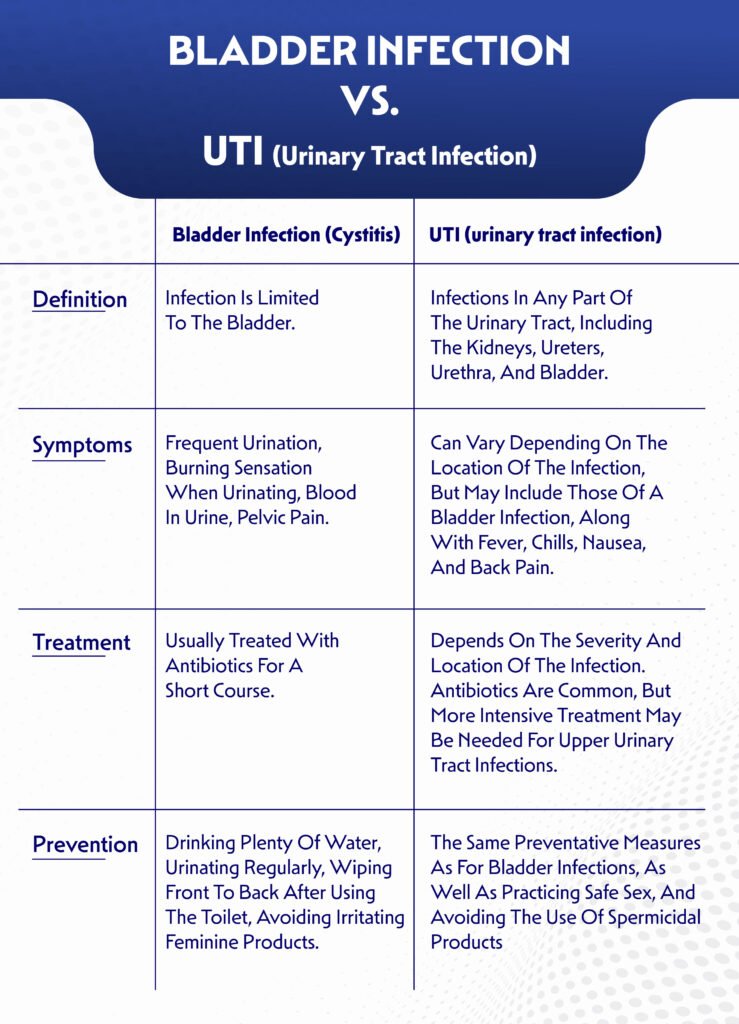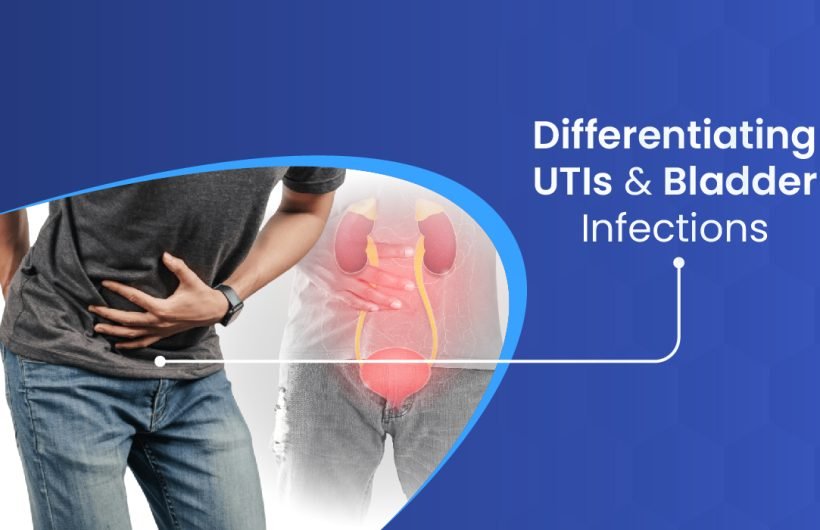Urinary Tract Infections (UTIs) and bladder infections are common ailments that affect millions of people worldwide, causing discomfort and inconvenience. While these terms are often used interchangeably, it’s essential to understand the distinctions between them for accurate diagnosis and effective treatment. In this comprehensive guide, we will delve into the bladder infection treatments, symptoms, and preventative measures associated with both UTIs and bladder infections.

Understanding Bladder Infections
Bladder infection, also known as cystitis, primarily affects the bladder , a vital organ in the urinary system. The most common cause is the presence of bacteria, such as Escherichia coli (E. coli), in the urinary tract. Symptoms of a bladder infection include frequent and urgent urination, a burning sensation during urination, and cloudy or strong-smelling urine.
Bladder Infection Treatment
Prompt and appropriate treatment is crucial to alleviate symptoms and prevent complications associated with bladder infection. Antibiotics are the primary line of defense, targeting the bacteria causing the infection. It is essential to complete the prescribed antibiotic course to ensure the complete eradication of the bacteria. Additionally, increased fluid intake and avoiding irritants like caffeine and alcohol can contribute to a faster recovery.
Understanding UTIs
Urinary Tract Infections (UTIs) encompass infections in any part of the urinary system, including the bladder, urethra, ureters, and kidneys. The symptoms of a UTI may overlap with those of a bladder infection but can extend to more severe complications if not addressed promptly. UTIs are more common in women due to their shorter urethra, making it easier for bacteria to reach the bladder.
UTI Treatment
UTI treatment involves a similar approach to that of bladder infection, with antibiotics playing a crucial role. However, the choice of antibiotics may differ based on the severity and location of the infection. In more complicated cases, such as kidney infections, hospitalization and intravenous antibiotics may be necessary. It is vital for individuals experiencing UTI symptoms to seek medical attention promptly to prevent the infection from spreading to other parts of the urinary tract.
Certain tactics that can be used at home can also lessen UTI discomfort. Among them are:
- Hydration: Staying hydrated can be achieved by consuming lots of liquids. They might also encourage more urination.
- Painkillers: Acetaminophen (Tylenol), a painkiller, can help reduce the discomfort associated with a urinary tract infection. These medications won’t, however, cure the infection, therefore medical attention is still necessary.
- Steer clear of sexual activity: Having sex while suffering from a urinary tract infection (UTI) is advised to prevent the spread of bacteria in the urinary tract.
Bladder Infection vs. UTI
While both UTIs and bladder infection share common symptoms, the key difference lies in the extent of the infection within the urinary tract. Bladder infections are localized to the bladder, whereas UTIs encompass a broader spectrum, affecting various parts of the urinary system. Understanding this distinction is crucial for healthcare providers to prescribe the most effective treatment.
Prevention Strategies
Preventing recurrent bladder infections and UTIs involves maintaining good urinary hygiene. Drinking plenty of water, emptying the bladder regularly, and practising safe hygiene habits can reduce the risk of bacterial growth. Additionally, wearing breathable underwear and avoiding irritants can contribute to a healthier urinary tract.
When to see a Doctor in this Case?
Waiting for the body to heal itself from a UTI is risky, even if it can happen occasionally. Serious kidney infections can arise from UTIs when they spread quickly.
Any UTI symptoms should be treated by a physician, especially if the patient is pregnant or has a medical condition that compromises their immune system. When a person exhibits signs of a kidney infection, they should visit the emergency department very once. The following are signs of a kidney infection-fever, chills, and intense nausea, along with back discomfort that gets worse when you push on it.
Conclusion
In conclusion, understanding the differences between bladder infection vs UTI is essential for accurate diagnosis and proper treatment. Both conditions can cause significant discomfort, but with timely medical intervention and preventative measures, individuals can minimize their risk and maintain a healthy urinary system.
If you suspect you have a bladder infection or UTI, consult with a urology doctor for personalized advice and treatment. Dr. Saket Narnoli is a famous urologist in Dhanbad, who specializes in consultant urologist, andrologist, uro-oncologist and laparoscopy Surgery, and more. He is a passionate urologist and surgeon, having done his thesis on Laparoscopic treatment in functional and non-functional adrenal tumors.






